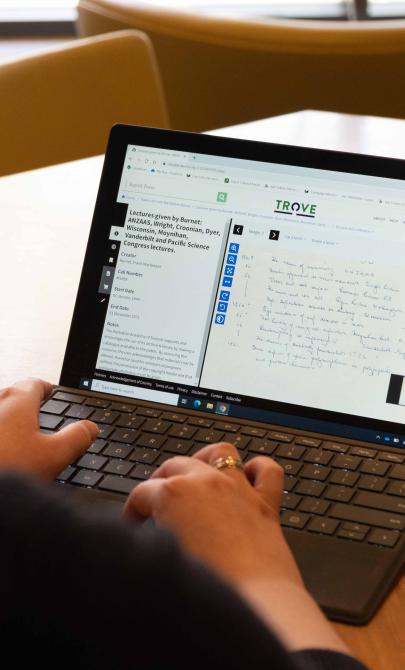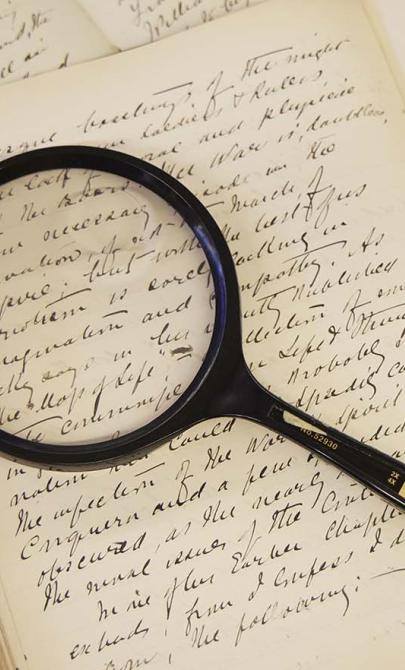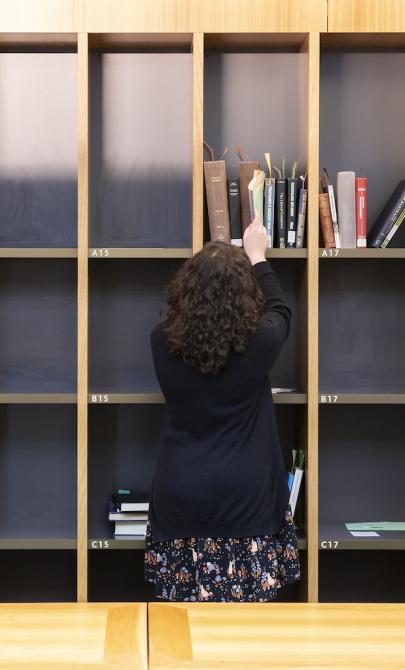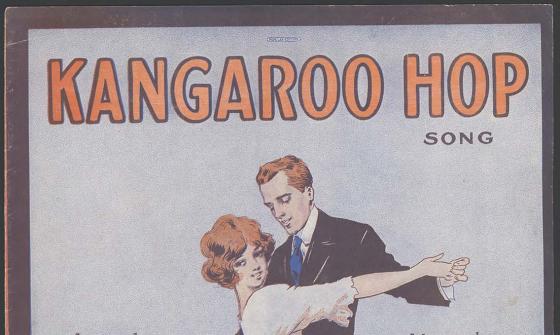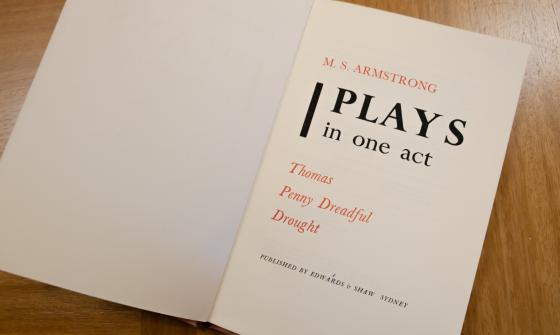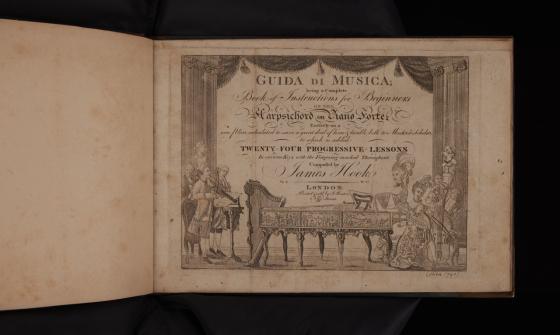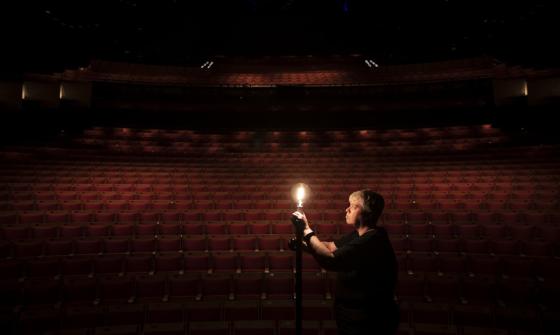Williamson Collection
Key items in the collection
This collection hosts a range of formats, including:
Records of J.C. Williamson, 1874-1976
The J.C. Williamson Ltd archives include 578 boxes and 7 cartons of materials, as the music, photographs, programs, and magazines have been moved to other collections. The largest part of this archive contains manuscript and typescript playscripts and libretti (339 boxes). While it includes a few earlier works, most of the plays were written by British and American authors during the first half of the twentieth century. Some notable writers represented are:
- Michael Arlen
- Dion Boucicault
- Noel Coward
- Arthur Conan Doyle
- Frederick Lonsdale
- W. Somerset Maugham
- Arthur Pinero
- Ivor Novello
- J.B. Priestley
- Terence Rattigan
- Ben Travers
- Edgar Wallace
- Emlyn Williams
- Tennessee Williams
A small selection of works by Australian playwrights, including Randolph Bedford, Dymphna Cusack, Ray Lawler, Gwen Meredith, Rex Rienits, A.G. Stephens, and Louis Stone, is also included.
The archives contain some early legal records and correspondence, especially letters from George Musgrove in London to J.C. Williamson in Melbourne (1893-1900). Agreements and contracts range from 1897 to 1970, although most business records focus on the later years of the company. Additional documents include extensive correspondence (1962-74), financial accounts (1920-76), theatre takings (1969-73), box office and bookings (1971-78), wages and salaries (1943-76), technical notes, stage production details, advertising (1953-76), and various addresses. There are also several scrapbooks (1933-60) and many published items.
This collection features a salary book (1933-43) that records the salaries and allowances of all actors for each production.
This collection contains agreements, contracts, and correspondence between J.C. Williamson Ltd and 43 artists from 1913 to 1960, including:
- Maurice Chevalier
- Gracie Fields
- Cecil Kellaway
- Marjorie Lawrence
- Nellie Melba
- Gladys Moncrieff
- Max Oldaker
- Anna Pavlova
- Roy Rene
Personal papers
The Tait Family papers consist of 19 boxes of personal and business correspondence, cables, financial and legal documents, performance contracts, newspaper clippings, and the manuscript of Viola Tait’s book A Family of Brothers (1971). The correspondence among the four brothers is especially strong from 1915 to 1923, covering the period when J. & N. Tait merged with J.C. Williamson Ltd.
Papers of Charles Tait, 1885-1965
Charles Tait’s papers include a compilation titled Actors, Plays, Musicians and Concerts, 1885-1932, as well as letters, a J.C. Williamson letterbook (1899-1900), legal agreements, and a typescript on grand opera in Australia.
Papers of Romola Hanstein, 1905-1970
This collection contains letters, programs, photographs, music, and other papers belonging to Romola Hanstein (Hansen), an actress who starred in many J.C. Williamson productions between 1927 and 1937.
Papers of Harald Bowden, 1938-1965
Harald Bowden’s papers include correspondence, manuscript and typescript notes, programs, newspaper clippings, and photographs. Bowden served as the general manager of J.C. Williamson Ltd from 1934 until his retirement in 1966.
A scrapbook (1899-1901) created by actress Georgina Musgrove, the niece of George Musgrove, features theatrical clippings, programs, and images, mainly from J.C. Williamson productions.
Papers of Sir George Tallis, 1889-1948
The papers of Sir George Tallis occupy 13 boxes and include correspondence (1889-1932), legal and financial documents, a diary from an overseas trip (1902), scrapbooks, programs, posters, photograph albums, and loose photographs. This collection also contains memoirs written by him in 1948 and biographical materials collected by Michael Tallis.
The largest part of the J.C. Williamson archives consists of about 1,200 boxes filled with printed and manuscript scores for 363 operas, light operas, musical comedies, musicals, and musical plays. This collection includes full scores, vocal scores, instrumental and chorus parts, as well as libretti and playscripts. It features works from Struck Oil, which was a big hit in 1874, all the way to Stephen Sondheim’s A Little Night Music (c. 1973).
Notable operas in the collection
Some of the operas you can find here include:
- The Barber of Seville (Rossini)
- Carmen (Bizet)
- Don Carlos (Verdi)
- Faust (Gounod)
- Il Trovatore (Verdi)
- Lohengrin (Wagner)
- Lucia di Lammermoor (Donizetti)
- Macbeth (Verdi)
- Rigoletto (Verdi)
Examples of musicals and operettas
The collection also features a wide variety of musicals, operettas, and musical plays, including:
- Annie Get Your Gun (Irving Berlin)
- Anything Goes (Cole Porter)
- The Boys from Syracuse (Richard Rodgers)
- Camelot (Frederick Loewe)
- Dancing Years (Ivor Novello)
- Fiddler on the Roof (Jerry Bock)
- The Gondoliers (Arthur Sullivan)
- The Gypsy Baron (Johann Strauss)
- Kiss Me, Kate (Cole Porter)
- Mame (Jerry Herman)
- The Mikado (Arthur Sullivan)
- My Fair Lady (Frederick Loewe)
- Oklahoma! (Richard Rodgers)
- Oliver! (Lionel Bart)
- Show Boat (Jerome Kern)
- The Student Prince (Sigmund Romberg)
Additionally, the collection includes about 200 miscellaneous works, such as overtures, songs, piano pieces, dances, marches, ballet suites, arrangements, and selections from operas.
The J.C. Williamson archive includes several hundred costume designs, primarily in watercolours, from early productions. Some notable productions represented are:
- Carmen Up to Date (1893)
- The Girl from Utah
- The Girls of Gottenberg (1907)
- The Merry Monarch (1891)
- Princess Caprice (1912)
- Tapu (1904)
- Who’s Hooper
Most of the designers are unknown, but Will R. Barnes created the costume designs for Alfred Hill’s opera Tapu.
The J.C. Williamson archive contains around 4,000 photographs. These images are from about 210 productions, including plays, operettas, variety shows, and musicals. Most of these are posed photos taken during dress rehearsals for publicity purposes. There are also a few rehearsal shots and images of staged publicity events, audiences, and theatre interiors.
Featured productions
Some notable productions represented in the collection are:
- Ma mie Rosette (1894)
- Canary Cottage (1917)
- Katja the Dancer (1926)
- All the King’s Horses (1927)
- Ballet Russe (1936)
- Balalaika (1937-38)
- Private Lives (1940-41)
- The Girl Friend (1942-43)
- Blithe Spirit (1945)
- Family Album (1946)
- Gay Rosalinda (1946)
- Annie Get Your Gun (1948, 1950, 1963)
- Oklahoma! (1949)
- Kiss Me, Kate (1952)
- Call Me Madam (1953)
- Charley’s Aunt (1954)
- The Reluctant Debutante (1956)
- My Fair Lady (1959, 1964, 1970)
- Bye Bye Birdie (1961)
- Black Theatre of Prague (1964)
- Camelot (1964)
- Great Moscow State Circus (1965, 1971)
- Funny Girl (1966)
- Fiddler on the Roof (1967-69)
- Mame (1968)
- Twelfth Night (1970)
- The Front Page (1973)
- No, No Nanette (1973)
- Gypsy (1975)
The archive also includes photographs from overseas productions.
In addition to production photos, the collection has many studio portraits of actors, dancers, and musicians, including Edouard Borovansky, Gordon Chater, Hayes Gordon, Kathleen Gorham, Toni Lamond, Cyril Ritchard, and Sybil Thorndike. Notable photographers include Sam Hood, Laurence Le Guay, Monte Luke, and Athol Shmith.
There is also the Viola Tait Collection, which features about 700 photographs, cabinet cards, and postcards related to J.C. Williamson tours, productions, performers, and other theatrical identities. This collection includes costume and set designs from Gilbert and Sullivan productions and musicals like The Desert Song, The Maid of the Mountains, South Pacific, and The Student Prince. Featured performers include Clara Butt, Eric Edgley, Madge Elliott, Gracie Fields, Margot Fonteyn, Harry Lauder, John McCallum, Gladys Moncrieff, Cyril Ritchard, and Nellie Stewart.
An extensive collection of J.C. Williamson programs, flyers, and magazines spans approximately 1882 to 1975, totaling 151 boxes. Highlights include:
- Opera Programs: Covers from 1901 to 1965.
- Gilbert and Sullivan Programs: Available from 1882 to 1969.
- Bound Programs:
- Theatre Royal: 1946 to 1965
- Empire Theatre: 1949 to 1960
- Her Majesty’s Theatre, Sydney: 1960 to 1969
Additionally, the collection features J.C.W. Magazine from 1947 to 1954, along with a bound set from 1927 to 1940.
- Ian Bevan, The story of the Theatre Royal, 1993
- Ian G. Dicker, J.C.W.: a short biography of James Cassius Williamson, 1974
- Corille Fraser, Come to dazzle: Sarah Bernhardt’s Australian tour, 1998
- Eric Irvin, Theatre comes to Australia, 1971
- Claude Kingston, It doesn’t seem a day too much, 1971
- Harold Love, ed., The Australian stage: a documentary history, 1984
- Viola Tait, A family of brothers: the Taits and J.C. Williamson: a theatre history, 1971
- Michael and Joan Tallis, The silent showman: Sir George Tallis, the man behind the world’s largest entertainment organisation of the 1920s, 1999 [new ed. 2006]
- John West, Theatre in Australia, 1978
About James Cassius Williamson
James Cassius Williamson (1845-1913) was born in Mercer, Pennsylvania, and joined a theatre company as a young boy. He gained fame as a dialect comedian. In 1871, he moved to San Francisco, and two years later, he married fellow comedian Margaret Sullivan, also known as Maggie Moore. They found success with their comedy show Struck Oil, which they brought to Australia in 1874.
Expanding the theatre scene
In 1879, Williamson and Maggie purchased the Australasian rights to H.M.S. Pinafore and returned to Sydney. The following year, he formed the Comic Opera Company and became the sole lessee of the Theatre Royal in Melbourne. Partnering with Arthur Garner and George Musgrove, they brought notable artists to Australia, including George Rignold, Dion Boucicault, and Sarah Bernhardt. In 1886, they opened the new Princess’s Theatre in Melbourne with a performance of The Mikado. Their partnership ended in 1899.
A legacy in theatre
In 1904, Williamson teamed up with George Tallis, his manager in Melbourne. By 1911, they merged with theatrical entrepreneurs Rupert Clarke and Clyde Meynell to form J.C. Williamson Ltd. After Williamson's death in 1913, Tallis took over the company, with E.J. Tait as general manager. In 1920, they merged with J. & N. Tait, with Tallis and Tait as joint managing directors. They controlled a network of theatres across Australia and New Zealand from the Comedy Theatre in Melbourne.
J.C. Williamson Ltd organised successful tours for artists like Nellie Melba and Anna Pavlova, and later brought famous ballet companies like the Ballets Russes and the Bolshoi Ballet to Australia. The company was known for its productions of Gilbert and Sullivan operas and popular musicals such as Annie Get Your Gun (1947), Oklahoma! (1949), and My Fair Lady (1959).
However, in the late 1950s and 1960s, J.C. Williamson Theatres Ltd lost its dominant position due to competition from television and cinema. Sir Frank Tait, the last surviving brother, organised a tour for Joan Sutherland in 1965 but passed away shortly after. The company struggled with changes in management and ownership. By 1976, its theatres were sold, and the name was leased out.
Background to the collection
The archive of J.C. Williamson Theatres Ltd was acquired in 1978, featuring a rich collection of materials like business records, playscripts, libretti, music, programs, magazines, books, costume designs, and photographs.
In 1994, Lady Tait, the wife of Sir Frank Tait, generously donated the Tait Family's papers and photographs. The Tallis family added more Tait papers in 1999 through a bequest. Sir George Tallis’s papers were passed down from his son, John, that same year, while his nephew, Michael Tallis, contributed additional materials between 2002 and 2003. Joyce Bowden, the daughter of Harald Bowden, also donated his papers in 1989.
The archives of J.C. Williamson Ltd and personal papers are located in the Manuscript Collection. Use the:
- Sir George Tallis’s papers finding Aid (MS 9522)
- Tait Family papers finding Aid (MS 309)
The scores of operas, musicals, and other works performed by J.C. Williamson are grouped together in the Music Collection. They are arranged alphabetically by the name of each work and catalogued under the prefix MUS JCW.
Paintings, drawings, and photographs are stored in the Pictures Collection at various locations. Most items in the J.C. Williamson archives have been individually catalogued, and many have been digitised. The Viola Tait Collection has also been catalogued, with most items digitised.
Programs, magazines, and other printed materials are kept in the PROMPT Collection. These items are organised into eight categories:
- Bound volumes of programs and magazines
- General (94 boxes, alphabetical by production name)
- Magazines (1927-54, 24 boxes)
- Opera (1901-65, 17 boxes)
- Gilbert and Sullivan (1882-1969, 9 boxes)
- Pantomime (4 boxes)
- Overseas productions (1 box)
- Posters (27 items)
This guide was prepared using these references:
- Richard Stone, The business of show business: the Tallis Collection, National Library of Australia News, vol. 12 (10), July 2002, pp. 11-14
- John Thomson, The J.C. Williamson Collection of Photographs: a visual record of popular theatre, National Library of Australia News, vol. 15 (9), June 2005, pp. 3-6
- Helen M. Van der Poorten, Williamson, James Cassius (1845-1913), Australian Dictionary of Biography online
- F. Van Straten, Tait, Sir Frank Samuel (1883-1965), Australian Dictionary of Biography online
- John West, J.C. Williamson’s, Companion to Theatre in Australia, edited by Philip Parsons, Sydney, Currency Press, 1995, pp. 299-304
First posted 2008 (revised 2019 and 2024)
